🎹 Agri-Silviculture Systems
Taungya, Alley Cropping, Shelter Belts, Wind Breaks etc.
Classification of agroforestry systems
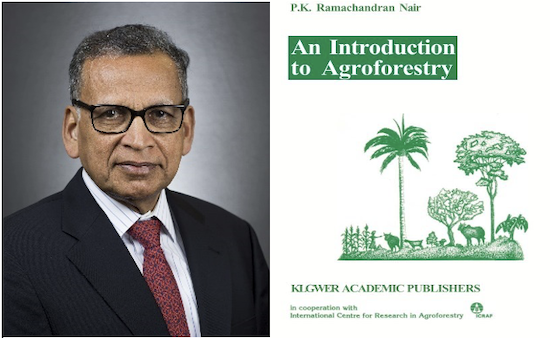
Nair(1987) has classified the agroforestry systems based on the four criteria viz.,
- Structural Basis
- Functional Basis
- Socioeconomic Basis
- Ecological Basis
- An Introduction to Agroforestry written by P.K. Nair
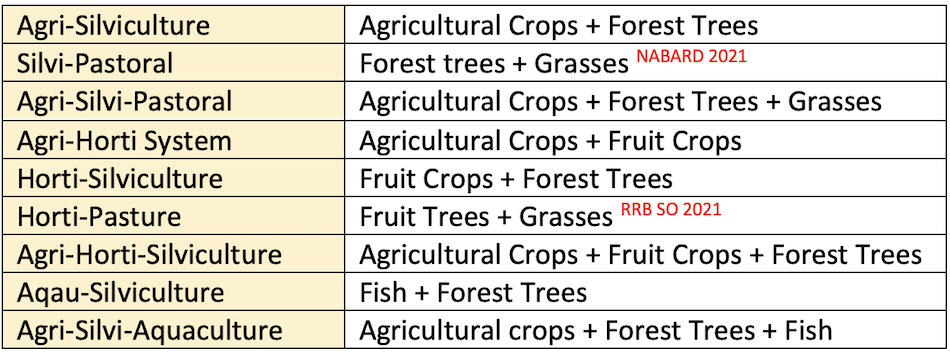
Structural Basis
- It is most important and commonly adopted classification of agroforestry.
- Based on the types of components and their arrangements –
- A. Nature of component
- B. Arrangement of component
Based on the Nature of Components
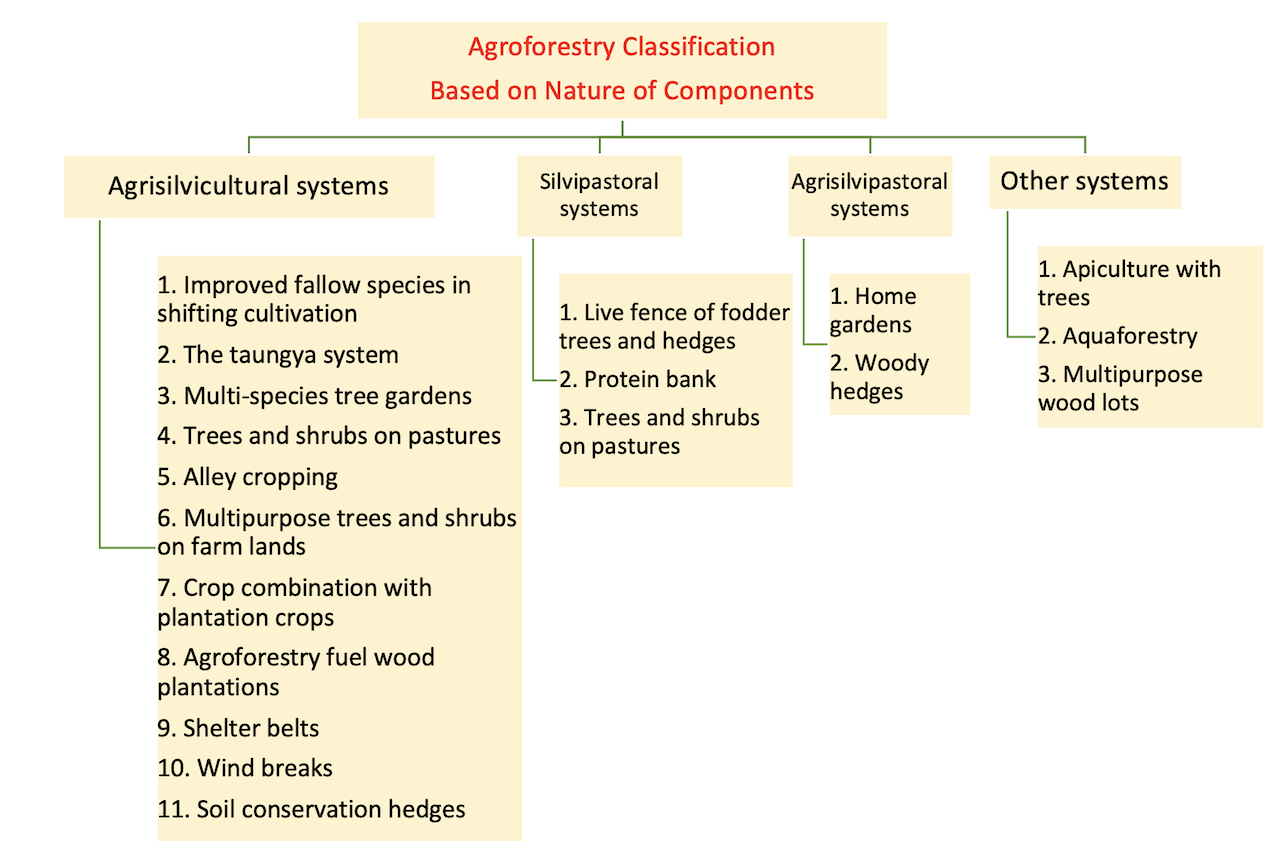
- Agrisilviculture systems/ silviagriculture/ agrosilviculture
- Silvopastoral systems/ silvipastoral
- Agrosilvopastoral systems/ agrisilvipastoral
- Other systems

Agrisilviculture/Silviagriculture/Agrosilviculture
- This system involves the conscious and deliberate use of land for the concurrent production of agricultural crops including tree, crops and forest crops.
- Silviagriculture agroforestry system, agricultural crops is of secondary importance.
- Based on the nature of the components this system can be grouped into various forms:
- Improved fallow species in
shifting cultivation - Taungya system
- Multispecies tree gardens
- Alley cropping (Hedgerow inter-cropping)
- Multipurpose trees and shrubs on farmlands
- Crops combination with plantation crops
- Agroforestry for fuelwood production
- Shelter belts
- Wind breaks
- Soil conservation hedges etc.
- Improved fallow species in
Improved fallow species in shifting cultivation:
👉🏻 Shifting cultivation (Slash & Burn Cultivation)
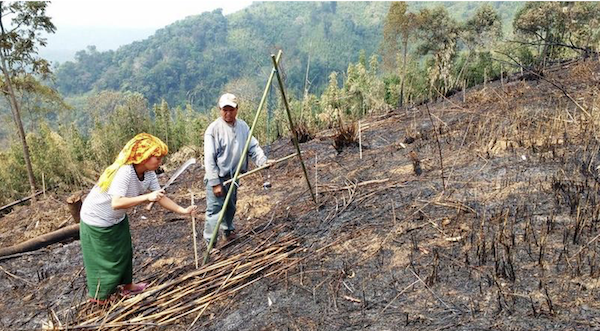
- The oldest known agroforestry system is shifting cultivation.
- The main feature of the improved fallow system of agroforestry is that trees and shrubs are not grown with crops on the same plot at the same time.
- Shifting cultivation is most prevalent in
North-Eastern India. - In north eastern hill region, shifting cultivation is called as
Jhum. - In India it is prevalent in Assam, Meghalaya, Manipur, Nagaland, Arunanchal Pradesh, Mizoram, Jharkhand, Tripura, West Bengal, Sikkim, Orissa, Chattisgarh, M.P., Andhra Pradesh, & Kerala.
- It is known as ‘Khallu / Kurwa’ in Jharkhand and ‘Dahiya’ or
Poduin Orissa, Andhra Pradesh. - In this system, forest patch is selected and cleared felled. The herbs, shrubs and twigs and branches (slashed vegetation) are burnt. Cultivation of crops is done for a few years until soil fertility declines. The site is then abandoned (fallow period) and new patch is selected for cultivation of crops. The site is again cultivated after giving rest for few years.
- Earlier the fallow cycle was of 20–30 year. However, due to increasing requirement for cultivation of land due to population pressure, fallow period has reduced from 25–30 years to 2–3 years which has broken down the resilience of ecosystem and the land is increasingly deteriorating. Thus, now shifting cultivation has become source of ecological degradation, soil erosion and converting good forests into wastelands.
- Improved Fallow system: practiced in North East India where existing shifting cultivation is improved through the inclusion of trees with high yield crop varieties.
Taungya system
- This is a modified form of shifting cultivation in which the labour is permitted to raise crops on the land, but, with this, they are responsible for planting, of the forest species, also for protection and wellbeing of the plantation. After about five years, or so, they are required to move to another patch of land.
- The taungya system was used primarily as an inexpensive means of establishing timber plantations but is finally a recognized AF system.
- The taungya (taung = hill, ya = cultivation) is a
Burmeseword coined inBurma(Mayanmar) in 1850s. - In reference to Agroforestry culture of combined stand of Woody and agricultural species during early stage of establishment of plantation is known as taungya. RRB-SO 2019
- This is a modified form of shifting cultivation in which the labour is permitted to raise agri-crops in an area but only side by side with the forest species planted by it.
- The practice consists of land preparation, tree planting, growing agricultural crops for 1-3 years, until shade becomes too dense, and then moving on to repeat the cycle in a different area.
- This system was introduced to raise forest plantations, but finally became recognized agroforestry system.
- In southern India, the system is called
kumri. - It is practiced in the areas where annual rainfall is 1200 to 1500 mm.
Types of Taungya
- Departmental Taungya: Under this, agricultural crops and plantation are raised by the forest department by employing a number of laborers on daily wages. The main aim of raising crops along with the plantation is to keep down weed growth.
- Leased Taungya: The plantation land is given on lease to the person who offers the highest money for raising crops for a specified number of years and ensures care of tree plantation.
- Village Taungya: This is the
most successfulof the three taungya systems. In this crops are raised by the people who have settled down in a village inside the forest for this purpose. Usually, each family has about 0.8 to 1.7 ha of land to raise trees and cultivate crops for 3 to 4 years.
Multi-species tree Gardens

- In this system of agroforestry, various kinds of tree species are grown mixed.
- The major function of this system is production of food, fodder and wood products for home consumption and sale.
Alley cropping (Hedge row intercropping)

- Alley cropping, also known as
hedgerow intercropping. - In this perennial, preferably
leguminoustrees or shrubs are grown simultaneously with an arable crop. - The trees, managed as hedgerows, are grown in wide rows and the crop is planted in the interspace or ‘alley’ between the tree rows.
- During the cropping phase the trees are pruned, and leaves and twigs are used as mulch on the cropped alleys in order to reduce evaporation from the soil surface, suppress weeds and/or add nutrients and organic matter to the topsoil.
- The primary purpose of alley cropping is to maintain or increase crop yields by improvement of the soil and microclimate and weed control. Farmers may also obtain tree products from the hedgerows, including fuelwood, building poles, food, medicine, and fodder, etc.
Layout of Alley
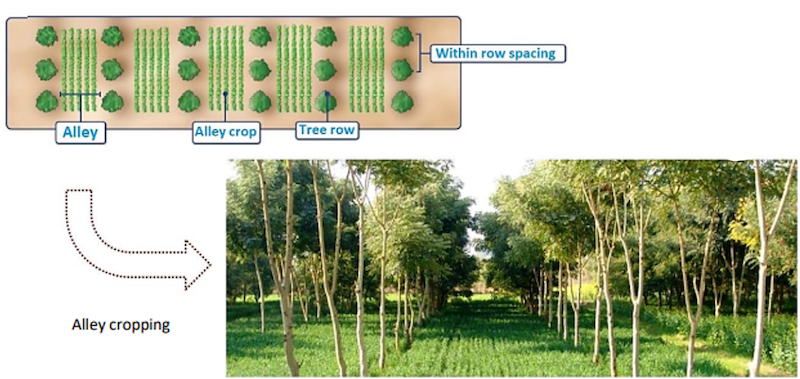
- The position and spacing of hedgerow and crop plants in an alley cropping system depend on plant species, climate, slope, soil conditions and the space required for the movement of people.
- Ideally, hedgerows should be positioned in an east to west direction so that plants on both sides receive full sunlight during the day.
- The spacing used in fields is usually 4 to 8 meters between rows and 25 cm to 2 meters between trees within rows. The closer spacing is generally used in humid areas and the wider spacing in sub-humid or semi-arid regions.
Agroforestry for fuelwood production
- In this system, various multipurpose fuelwood/firewood species are inter-planted on or around agricultural lands.
- The protective role is to act as fencing, shelter belts and boundary demarcation.
- Tree species commonly used as fuelwood are: Acacia nilotica, Albizia lebbek, Cassia siamea, Casuarina equisetifolia, Dalbergia sissoo, Prosopis juliflora, Eucalyptus tereticornis, etc.
Shelterbelt
- Shelterbelt is a
wide beltof trees, shrubs and grasses, planted in rows which goes right across the land at right-angle to the direction of the prevailing winds to deflect air current, to reduce wind velocity and to give general protection to cultivated areas against wind erosion and desiccating effect of the hot winds in lee-ward side. - A typical shelterbelt has a
triangular cross-sectionwhich can be achieved by planting tall trees in the centre, flanked on both sides successively by shorter trees, tall shrubs and then low spreading shrubs and grasses. - A certain amount of penetrability is desirable in shelterbelts as a result of which the zone of influence is very much greater and the velocity curve shows a smooth, slowly declining trend.
- The width of shelterbelt depends upon local climatic conditions, wind velocity, and the soil type.
- Shelterbelt should be oriented as nearly as possible, at right angles to the prevailing wind. In case, where winds blow from different directions, shelterbelt should be raised in quadrangles.

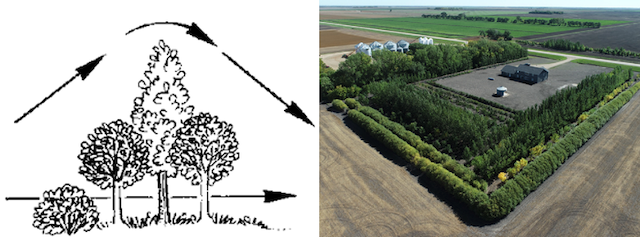
Height and spacing
- Height of shelterbelt is very important.
- As it affects the distance to which protection will be afforded on the lee-ward side.
- Higher the trees forming the shelterbelt, the greater is the zone of influence on the leeward side.
- This affects the spacing of the shelterbelts also. If wind erosion has to be completely controlled, the second belt should be located a little before the place where the wind on the lee-ward side often first shelterbelt assumes damaging velocity.
- Shelterbelt up to 50 m width with suitable spacing is ideal.
- Taking 20% reduction in wind velocity as the basis of usefulness of a shelterbelt, effective protection zone extends up to
15 to 20 timesthe height of the belt. - In Rajasthan, taking the height of shelterbelt to be about 7.5 m, spacing recommended is 10 times the height, i.e., 75 meters.
Length
- The length of shelterbelt is an important consideration because at the ends of the shelterbelt eddies are produced resulting in increasing the wind velocity at these places.
- It is because of this that road is not ordinarily allowed to cross a shelterbelt.
- In some of the western countries, shelterbelts have been raised right across the country for the protection they afford.
- For shorter shelterbelt, the minimum length of shelterbelt to be most effective is 24 times its height.
Windbreaks
- Windbreak refers to the strip of trees and/or shrubs planted in order to protect fields, homes, canals or other areas from wind and blowing soil.
- It protects the livestock from cold winds. Shelterbelt protects crops and pastures from hot and drying winds.
- Structure:

- Usually grow trees in
2-3 parallels rowsto block air sufficiently (may also possible in a single row). - Often, we see Eucalyptus & Casuarina (in the coastal area) for this purpose in 4-5 rows to work effectively.
- Advantages /Importance:
- Almost the same as shelterbelt, also suitable where land prices are heigh as it encroaches small areas.
- An agroforestry system suitable for small orchards prone to wind damage is
Windbreak.
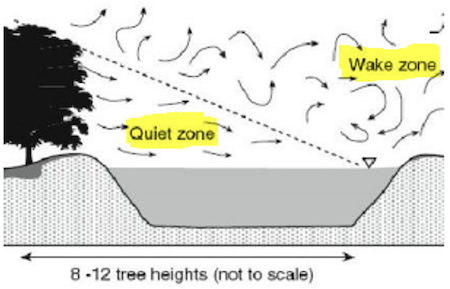
Soil conservation hedges
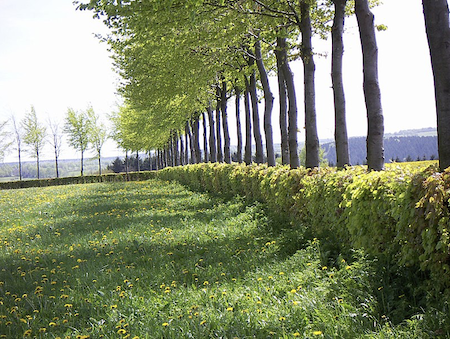
- In this system, trees can be planted on soil conservation works such as bonds and terraces.
- These trees augment the conservation work through stabilization of soil.
- The interception of rain and obstruction of wind reduces the soil erosion.
- E.g. Grevillea robusta, Acacia catechu, Pinus roxburghii, Acacia modesta, Prosopis juliflora, Abuts nepalensis, and Leucaena leucocephala are commonly used for this purposes with grasses.
Horticilviculture
- It is deliberately integration of horticultural trees with timber trees in order to harvest fruits and timber concurrently from single unit of land.
- Timber trees are planted on bunds of the orchards acts as windbreak thus protect orchard from high winds.
Classification of agroforestry systems

Nair(1987) has classified the agroforestry systems based on the four criteria viz.,
- Structural Basis
- Functional Basis
- Socioeconomic Basis
- Ecological Basis
- An Introduction to Agroforestry written by P.K. Nair

Structural Basis
- It is most important and commonly adopted classification of agroforestry.
- Based on the types of components and their arrangements –
- A. Nature of component
- B. Arrangement of component
Based on the Nature of Components

- Agrisilviculture systems/ silviagriculture/ agrosilviculture
- Silvopastoral systems/ silvipastoral
- Agrosilvopastoral systems/ agrisilvipastoral
- Other systems

Agrisilviculture/Silviagriculture/Agrosilviculture
- This system involves the …
Become Successful With AgriDots
Learn the essential skills for getting a seat in the Exam with
🦄 You are a pro member!
Only use this page if purchasing a gift or enterprise account
Plan
Rs
- Unlimited access to PRO courses
- Quizzes with hand-picked meme prizes
- Invite to private Discord chat
- Free Sticker emailed
Lifetime
Rs
1,499
once
- All PRO-tier benefits
- Single payment, lifetime access
- 4,200 bonus xp points
- Next Level
T-shirt shipped worldwide

Yo! You just found a 20% discount using 👉 EASTEREGG

High-quality fitted cotton shirt produced by Next Level Apparel